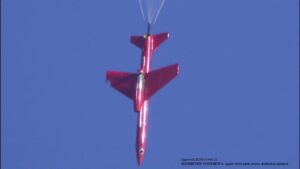The Navy’s research agency successfully demonstrated a high-energy laser defeating a cruise-missile type target in recent months, the Navy said on April 13.
The all-electric high-energy Lockheed Martin
[LMT] Layered Laser Defense (LLD) system shot down the “target representing a subsonic cruise missile in flight” in February during a test conducted by the Office of Naval Research (ONR). The test occurred at the Army’s High Energy Laser Systems Test Facility at White Sands Missile Range, N.M.
This demonstration was a partnership among ONR, the Office of the Under Secretary of Defense (Research and Engineering) and Lockheed Martin.
In the test, the drone was hit by the invisible high-energy beam, smoke came out of its engine and a parachute opened as it fell out of the sky after being disabled by the LLD. ONR underscored this was the first time the Navy used any such laser weapon to defeat a cruise missile-representative target.

The Navy said during the testing, LLD also tracked and shot down several targets including unmanned fixed-wing aerial vehicles and quadcopters.
LLD was built as a multi-domain and multi-platform demonstration system. ONR said it can target unmanned aerial systems and fast-attack boats while using a high-resolution telescope to track in-bound air threats, support combat identification and conduct battle damage assessment of targets.
“Lockheed Martin drew best-in-class laser weapon subsystems from across the corporation, including key industry partner Rolls-Royce, to support the entire threat engagement timeline from target detection to defeat,” Rick Cordaro, vice president of Lockheed Martin Advanced Product Solutions, said in a statement.
The Navy said this LLD testing supports the larger research and development effort to mature technologies and field a family of naval laser weapons. The Navy is seeking capabilities that range from non-lethal measures like optical dazzling and disabling sensors up to destroying targets via laser.
ONR said the Navy does not plan to field the LLD itself, but it shows what operational systems will look like since it is compact, more efficient than previous systems, has specialized optics, and uses artificial intelligence for improved tracking and targeting.
“LLD is an example of what a very advanced laser system can do to defeat significant threats to naval forces. And we have ongoing efforts, both at ONR and in other Navy programs, to keep building on these results in the near future,” David Kiel, a program officer in ONR’s Aviation, Force Projection and Integrated Defense Department, which managed the testing, said in a statement.
“Innovative laser systems like the LLD have the potential to redefine the future of naval combat operations. They present transformational capabilities to the fleet, address diverse threats, and provide precision engagements with a deep magazine to complement existing defensive systems and enhance sustained lethality in high-intensity conflict,” Chief of Naval Research Rear Adm. Lorin Selby added.
In 2020, ONR first awarded Lockheed Martin a $22 million contract to demonstrate and test a LLD prototype on a Littoral Combat Ship (Defense Daily, March 16, 2020).
The LLD comes amid several Navy laser programs. In 2020, a test of the Solid State Laser – Technology Maturation (SSL-TM) Laser Weapons System Demonstrator (LWSD) MK 2 MOD 0 installed on the USS Portland (LPD-27) amphibious transport dock successfully disabled an unmanned aerial vehicle (Defense Daily, May 26, 2020).
The LWSD is a follow-on to the 30-kilowatt (kW) Laser Weapons System tested on the USS Ponce for three years in the Middle East and was developed by Northrop Grumman [NOC].
Then late last year, the Portland’s laser demonstrator was successfully tested against a surface training target (Defense Daily, Dec. 16, 2021).
In January, Lockheed Martin revealed its 60-kW High Energy Laser and Integrated Optical-dazzler with Surveillance (HELIOS) system will be installed on the Arleigh Burke-class destroyer USS Preble (DDG-88) this year. HELIOS is designed to target unmanned aircraft and small boats while also providing a counter-UAS intelligence, surveillance and reconnaissance (ISR) dazzler capability (Defense Daily, Jan. 14).
Last year, the Navy also awarded VTG a contract to install and integrate the AN/SEQ-4 Optical Dazzler Interdictor, Navy (ODIN) on five more destroyers. VTG previously installed ODIN on two destroyers in a 2020 contracts (Defense Daily, July 22, 2021).